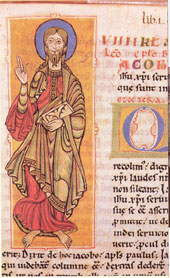Codex Calixtinus: Difference between revisions
No edit summary |
Phil Boswell (talk | contribs) moving notice to talk page |
||
| Line 1: | Line 1: | ||
{{slashdotted}} |
|||
[[Image:Codex Calixtinus (Liber Sancti Jacobi) F0173k.jpg|thumb|right|Detail from the Codex Calixtinus Folio 4r, showing [[Saint James the Great]] (c. 1130-1140)]] |
[[Image:Codex Calixtinus (Liber Sancti Jacobi) F0173k.jpg|thumb|right|Detail from the Codex Calixtinus Folio 4r, showing [[Saint James the Great]] (c. 1130-1140)]] |
||
The '''Codex Calixtinus''' is a [[12th century]] [[illuminated manuscript]] formerly attributed to [[Pope Callixtus II]], though now believed to have been arranged by the French scholar [[Aymeric Picaud]]. The principal author is actually given as ''Scriptor I''. |
The '''Codex Calixtinus''' is a [[12th century]] [[illuminated manuscript]] formerly attributed to [[Pope Callixtus II]], though now believed to have been arranged by the French scholar [[Aymeric Picaud]]. The principal author is actually given as ''Scriptor I''. |
||
Revision as of 08:12, 7 November 2005

The Codex Calixtinus is a 12th century illuminated manuscript formerly attributed to Pope Callixtus II, though now believed to have been arranged by the French scholar Aymeric Picaud. The principal author is actually given as Scriptor I.
It was intended as an anthology of background detail and advice for pilgrims following the "Way of St. James" to the grave of the apostle Saint James the Great, sited at the cathedral of Santiago de Compostela, Galicia. The codex is alternatively known as the Liber Sancti Jacobi, or the Book of Saint James.
The collection includes sermons, reports of miracles and liturgical texts associated with Saint James. In it are also found descriptions of the route, works of art to be seen along the way, and the customs of the local people.
History
It is thought that in order to lend authority to their work, the authors placed at the front of the book a forged letter purportedly signed by Pope Callixtus II (who had already died in 1124).
The earliest known edition of the codex is that held in the archives of the Catedral Metropolitana de Santiago de Compostela, and dates from about 1150. Another example of a similar age is known as The Ripoll, and is kept in Barcelona.
The book was well-received by the Church of Rome, and copies of it were to be found from Rome to Jerusalem, but it was particularly popular in Cluny.
Composition
The Santiago de Compostela copy comprises five volumes, totalling 225 double-sided folios each 295 by 214 mm. Its oversized pages were trimmed down during a restoration in 1966. With some exceptions, each folio displays a single column of thirty-four lines of text. Book IV had been torn off in 1609, either by accident or theft, and was reinstated during the restoration.
The letter of Pope Callixtus II which opens the book, occupies both recto and verso of the first two folios. The author, who claims to be Callixtus II, tells how he collected many testimonies on the good deeds of Saint James, "traversing the cruel grounds and provinces for fourteen years". He also describes how the manuscript survived many hazards from fire to drowning. The letter is addressed "to the very holy assembly of the basilica of Cluny" and to "Diego, archbishop of Compostela".
Book I - Book of the Liturgies
Book I accounts for almost half of all the codex and contains sermons and homilies concerning Saint James, two descriptions of his martyrdom and official liturgies for his veneration. Its relative size and the information it contains on the spiritual aspects of the pilgrimage make it the heart of the codex.
Book II - Book of the Miracles
The hagiographic Book II is an account of twenty-two miracles across Europe attributed to Saint James. The recipients and witnesses to these miracles are often pilgrims.
Book III - Transfer of the body to Santiago
Book III is the briefest of the five books and describes the transfer of the body of Saint James from Jerusalem to his tomb in Galicia. It also tells of the custom started by the first pilgrims of gathering souvenir sea shells from the coast of Galicia.
Book IV - The Conquests of Charlemagne
Book IV is attributed to Archbishop Turpín of Reims, although in fact it is the work of an anonymous writer of the 12th century. It describes the coming of Charlemagne to Spain, his defeat at the Battle of Roncevaux Pass and the death of the knight Roland. It relates how Saint James then appeared in a dream to Charlemagne, urging him to liberate his tomb from the Moors and showing him the direction to follow by the stars.
Book V - A Guide for the Traveller
Book V is a wealth of practical advice for pilgrims, informing them where they should stop, relics they should venerate, and sanctuaries they should visit. It also describes the city of Santiago de Compostela and its cathedral. The book provides a valuable insight into the life of the 12th century pilgrim.
The popular appeal of Book V led to it achieving the greatest fame.
Music
The Codex Calixtinus was intended to be chanted aloud and is of great interest to musicologists as an early example of polyphony. In particular, it contains the first known composition for three voices. The popularity of the music has continued to the present day with modern recordings commercially available.
References and further reading
- . ISBN 0934977259.
{{cite book}}: Cite has empty unknown parameters:|Chapter=,|Others=,|Editor=, and|Pages=(help); Missing or empty|title=(help); Unknown parameter|First=ignored (|first=suggested) (help); Unknown parameter|Last=ignored (|last=suggested) (help); Unknown parameter|Publisher=ignored (|publisher=suggested) (help); Unknown parameter|Title=ignored (|title=suggested) (help); Unknown parameter|Year=ignored (|year=suggested) (help)
